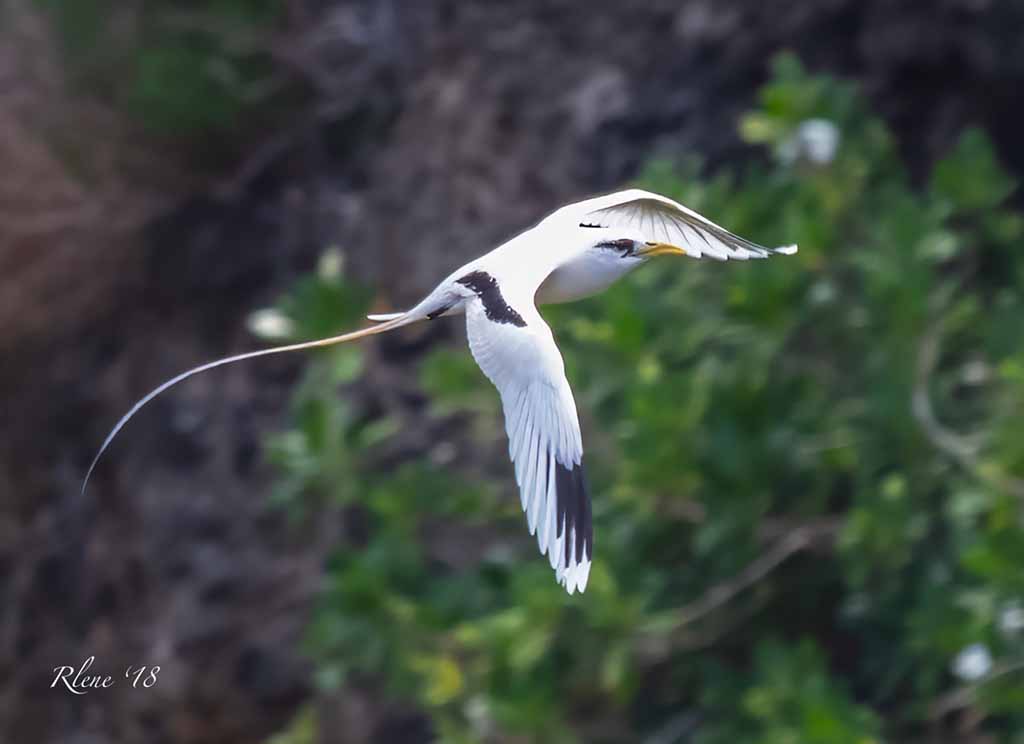Utak: Itak

Bearer of news
The utak or itak (Phaethon lepturu) is a bird Chamorros/CHamorus believe plays a role as providing an omen of life and death. The bird is native to the Caroline islands which are south of the Marianas. In ancient times, the CHamorus had a fear of the bird because it was said to appear only when storms would blow it northward, so they connected the bird to a sign of bad things to come.
Historian Lawrence Cunningham described the utak:
It is one of the most beautiful birds in the world. They had a set of two black markings on each wing. The bird’s most distinctive characteristic is the long, streaming feathers in its tail, which are longer than its body. Utaks feed on flying fish, other small fish, and squid. They can fly hundreds of miles in search of food. These beautiful birds can spend months at a time at sea. They nest on cliffs in the Mariana Islands. These birds are frequently seen at two lovers point. Fishermen use them to help them locate schools of mahimahi. Utaks are noisy and they will sometimes circle a ship at sea and scream.
Beliefs about the Utak
It is believed that the utak would perch on a house at night, emitting a long shrill cry and then disappear into the night. The utak’s appearance and its cry signified that a young unwed woman is pregnant or someone in the household is about to die.
The belief connected with the utak documents the practice of animism in CHamoru culture. Animism is a belief that nature or organisms contain a soul – and serve as a social behavioral authority and warning beacon. At one time CHamorus and Carolinians believed that the utak was an omen of violent weather. Inclement weather entailed disastrous shipwrecks, houses destroyed, and often times death. Shipwrecks bring an economic loss as goods are damaged or lost all together. Most houses were made of wood with a thatched roof. If the houses were blown away it would take a lot of work to rebuild them. With all the death and destruction that followed a storm, seeing the utak became known as a bad omen in CHamoru culture.
Beyond ushering in stormy weather, the utak has also been associated with the arrival of new life. Oral accounts of the utak have commonly referred to it as a mythical bird and as a bearer of life rather than death. It is believed that the utak would fly above a house. Although not seen, its presence was marked by a long shrill call. This visit meant one of two things: an unwed female in the house was pregnant or someone in the house was about to die. As CHamorus became devout Catholics, the institution of marriage was instilled into their social and ritualistic practices. Since then, pregnancy of an unwed woman brought shame to her family.
Some believed that if you saw the bird and showed it any measure of disrespect it could result in your death, so it was best to remain silent and still in its presence. If one did not believe that the utak was an omen, it was believed that he or she could be attacked and even killed by the bird.
Interpretations
The evolution of the utak as a bad omen throughout the centuries can be related to its presence during storms. Its evolution as an omen of new life during Guam’s Spanish colonial era (1668 – 1898) can be connected to Catholicism, the newly introduced religion. It was seen as a sin for an unwed girl to become pregnant which contradicted the ancient CHamorus’ acceptance of pregnant unwed women. In ancient times it was perfectly acceptable for a man to take an already pregnant woman as his wife because it was proof that she was fertile.
In contemporary society, although beliefs surrounding the utak are not as prevalent, the belief still does exist.
For further reading
Cunningham, Lawrence J. Ancient Chamorro Society. Honolulu: Bess Press, 1992.
Freycinet, Louis Claude Desaulses de. An Account of the Corvette L’Uraine’s Sojourn at the Mariana Islands, 1819. Translated by Glynn Barratt. Saipan: Commonwealth of the Northern Mariana Islands Division of Historic Preservation, 2003.
Onedera, Peter R. Fafa’ña’gue yan Hinengge Siha (Ghosts and Superstitious Beliefs). Tamuning: St. Anthony School, 1994.